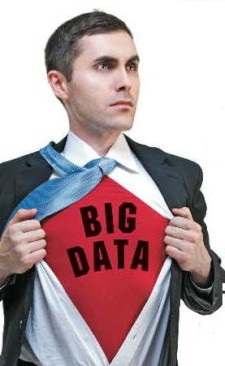
May 28, 2012
Thanks to a new generation of software and computing tools, in the future, book marketing will be determined by data rather than by intuition.
If you're a publishing executive and you haven't been reading about Big Data, then you soon will be. Big Data is just what it sounds like—data collections of such enormous size they are awkward, expensive, and impossible to process with conventional computing. Big Data also refers to the ability to use distributed computing—parsing out these huge data sets and processing them simultaneously on multiple computers—plus new software tools and deep analysis to create new kinds of predictive business models that will drive the decisionmaking in the future.
Big Data and Visualization
According to Edd Dumbill, program chair for Strata and the O'Reilly Open Source Convention, an ongoing series of conferences focused on Big Data, BD can be characterized by the "volume, variety, and velocity" of the data sets under question. In Big Data, these three aspects are typically so huge and the data so varied, conventional data processing is inadequate. At the same time, "visualization," or the ability to output all this data in some kind of visual and easily digestible form, is a critical element in the process that makes the results of Big Data useful to business managers and not just data specialists.
"Visualization is simply making data visual," explains Julie Steele, content editor for O'Reilly Media's Strata conferences. "It's using artistic elements, graphs, and charts to make data comprehensible. Visualization reduces large data sets to visual trends or patterns and relationships, with the goal of better decisionmaking, to get a better understanding of the world and of the future." The ability to process vast troves of data on customer behavior—data sets that would have been too expensive or taken far too long to process in the past—offers the potential to create predictive models for any business, and certainly for book publishing.
In an era when more people than ever are shopping online and consumers are making use of digital apps, e-books, and digital reading devices, all of which capture and transmit a wide variety of usage data back to publishers and retailers, "Big Data holds the promise of helping publishers make better decisions," Steele said. Publishers can get feedback on how long a reader stays on a certain page or why readers have stopped reading on a certain page. "E-books allow you to modify pricing, and data analysis will let you see how the market responds in real-time, and make changes," Steele says. Indeed the aggregation, processing, and deep analysis of this kind of data set gives publishers the ability to tie consumer purchases to a promotion, to their friends' purchases, to reviews, and more..
According to Edd Dumbill, program chair for Strata and the O'Reilly Open Source Convention, an ongoing series of conferences focused on Big Data, BD can be characterized by the "volume, variety, and velocity" of the data sets under question. In Big Data, these three aspects are typically so huge and the data so varied, conventional data processing is inadequate. At the same time, "visualization," or the ability to output all this data in some kind of visual and easily digestible form, is a critical element in the process that makes the results of Big Data useful to business managers and not just data specialists.
"Visualization is simply making data visual," explains Julie Steele, content editor for O'Reilly Media's Strata conferences. "It's using artistic elements, graphs, and charts to make data comprehensible. Visualization reduces large data sets to visual trends or patterns and relationships, with the goal of better decisionmaking, to get a better understanding of the world and of the future." The ability to process vast troves of data on customer behavior—data sets that would have been too expensive or taken far too long to process in the past—offers the potential to create predictive models for any business, and certainly for book publishing.
In an era when more people than ever are shopping online and consumers are making use of digital apps, e-books, and digital reading devices, all of which capture and transmit a wide variety of usage data back to publishers and retailers, "Big Data holds the promise of helping publishers make better decisions," Steele said. Publishers can get feedback on how long a reader stays on a certain page or why readers have stopped reading on a certain page. "E-books allow you to modify pricing, and data analysis will let you see how the market responds in real-time, and make changes," Steele says. Indeed the aggregation, processing, and deep analysis of this kind of data set gives publishers the ability to tie consumer purchases to a promotion, to their friends' purchases, to reviews, and more..
No comments:
Post a Comment